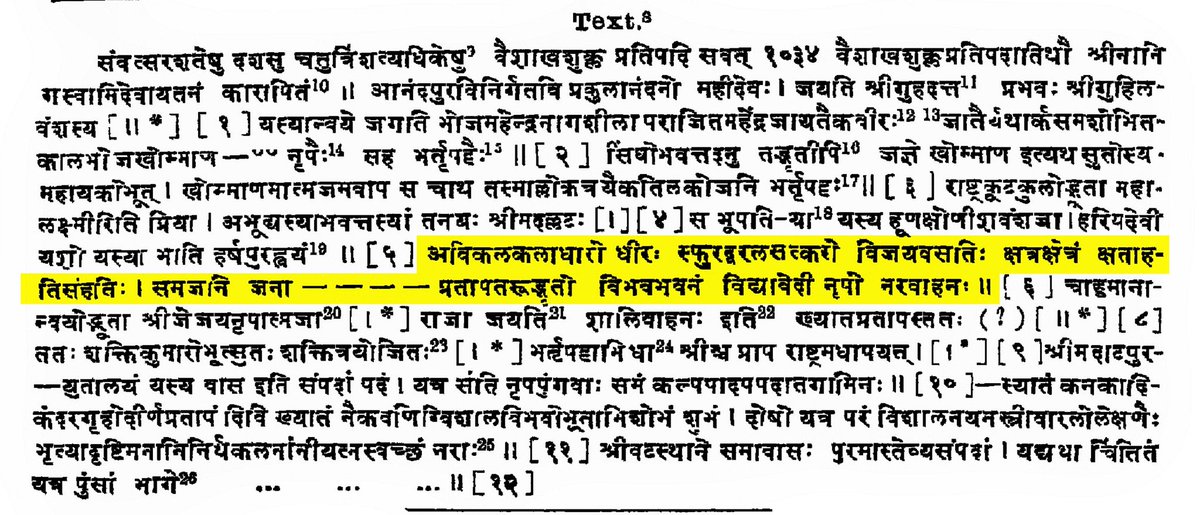A thread on the epigraphic records and literary evidences affirming the Suryavanshi Kshatriya lineage of the Guhilot/Sisodia Rajput & dispelling the erroneous narrative of their purported Brahmin origin. 

Initially, we have the gold coins that were minted during the reign of Bappa Rawal (728-764 CE). The depiction of the Sun positioned between two royal umbrellas (छत्र) on these coins serves as evidence of the Suryavanshi lineage of the Guhilot/Sisodia Rajputs. 

Then we have the Eklingji Inscription, dating back to 971 CE at the time of Guhil King Narvahan. Within this inscription, the phrase “रघुवंशकीर्तिपिशुना” (translated as The one who enhanced the glory of Raghu's lineage) is attributed to the members of the Mewar Royal family. 



DR Bhandarkar, in the course of publishing this inscription, deliberately chose to exclude the aforementioned phrase, resulting in a misinterpretation of the entire verse. 

Next we have the Atpur inscription of 977 CE, which, in the course of discussion regarding Guhil King Narvahan, references Anandpur as the sanctuary of triumph and the ancestral land of the Kshatriyas. underscoring its significance as the birthplace of the warrior class. 



This inscription serves as compelling evidence that Guhadatta & his lineage belonged to the Kshatriya caste. But again, DR Bhandarkar, while publishing this inscription, deliberately chose to misinterpret the aforementioned verse, resulting in this gross misapprehension. 

The Alha Khanda of Jagnik from the 12th century CE, alludes to the Guhilot as one of the esteemed tribes within the Kshatriya lineage. 

Rani Jayataladevi (mother of Maharawal Samar Singh) in Chittorgarh inscription of 1278 CE, referenced Simha (a member of the Guhilot dynasty of Mewar) as a Kshatriya.
Yet, it is not surprising to note that DR Bhandarkar had willfully overlooked this significant detail.
Yet, it is not surprising to note that DR Bhandarkar had willfully overlooked this significant detail.

Maharawal Samar Singh, as inscribed in the Mount Abu Stone Inscription of 1285 CE, eloquently proclaimed that the sovereigns of his lineage epitomized the principles of Kshatradharma. 

In the Varna Ratnakar, authored by the Jyotirishwar Thakkura in the year 1324 CE, the earliest known Maithili text, the Guhilot tribe is noted among the distinguished clans of Rajaputras/Kshatriyas. 

In the Ekalingaji stone inscription of 1428 CE, Ari Singh (father of Maharana Hammir Singh) is referenced as a Kshatriya. 

Maharana Mokal Singh (father of Maharana Kumbha) in the Shringi Rishi inscription dated 1428 CE, extolled his grandfather, Maharana Kshetra Singh, as “the illustrious gem of the Kshatriya lineage”. 

The Ekalingaji Stone Inscription from 1488 CE refers to Maharana Kshetra Singh as "The Lord of the Kshatriyas." 

The inscription of the Adinath temple, located in the Nadlai village, dating back to the year 1500 CE, references Shiladitya & Guhadatta of Mewar and their successors as the members of the illustrious Suryavanshi Kshatriya lineage. 

In Munhot Nainsi's khyat, the Guhilas' arrival in Nagda unfolds: Guhadatta's mother, upon learning of her husband's death in battle, chooses to become sati. After giving birth to her son, Guhadatta, she entrusts him to the Nagar Brahmin Vijayaditya, & becomes a Sati.
Before becoming sati, Guhadatta's mother, as she entrusts him to Vijayaditya, promises that for ten generations to come, the lineage of this child will uphold the traditions of Vijayaditya's family, embracing both royal responsibilities and sacred rites with unwavering devotion. 

This tradition recounted by Muhnot Nainsi in his khyat appears to align with the Atpur inscription of 977 CE, which references “He who brings delight to the Brahmin lineage from Anandpur”. The Brahmin lineage in question undoubtedly pertains to Vijayaditya, rather than Guhadatta. 

For those interested in the Chatsu inscription of Baladitya, the term “Brahma-Kshatriya” has been elucidated in the subsequent discussion.
https://x.com/arjunvanshi_/status/1824650198318030881?t=vXNoBVcsgXz19aeAuJr2yQ&s=19
In the inscription referenced, Bharttripatta Guhil is described as “Brahma-Kshatra,” drawing a comparison to Ram. However, DR Bhandarkar mistakenly identified Ram as Parshuram. 

Similarly, the Ekalingji stone inscription of 1488 CE refers to Bappa Rawal as a “Dwij.” but this does not definitively indicate his Brahmin status, as the term applies to Brahmins, Kshatriyas, and Vaishyas. (Vashishtha Dharmasutra Chapter 2). 

The term Mahideva (महिदेव) of Atpur Inscription of 977 CE exclusively signifies King, rather than Brahmin. 



Also, the “विप्रकुलानंदनो” verse of Atpur Inscription has been misconstrued by subsequent authors, leading to the emergence of a wholly fallacious and deceptive tradition. 

The narrative surrounding Bappa Rawal embracing the noble responsibilities of Rishi Harit, as chronicled in the Mount Abu Stone Inscription of 1285 CE, does not substantiate the Brahmin lineage of the Guhilots. 

Through meticulous examination and analysis of both epigraphic and literary evidence, it is unequivocally established that the Guhilot/Sisodia Rajput trace their lineage to the Suryavanshi Kshatriya heritage.
END OF THE THREAD
Ignore typos, if any.
Likes & Retweets appreciated
END OF THE THREAD
Ignore typos, if any.
Likes & Retweets appreciated
@_Rajanya_ @akanksha_sinngh @Ap_rajput99 @arjunavayana @D_Lich_King @Engr_Who @OliveGreens09 @R_G_T_Rajputana @ShandilyaRjapu1 @Thakur_Saab_84 @KshatriyaDialog @KshatriyaItihas @ruthlessrathore @Samvadkshtriya @TheVajrapani
• • •
Missing some Tweet in this thread? You can try to
force a refresh















